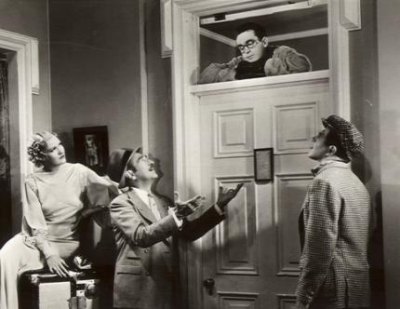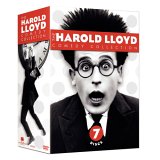| Reviews & Columns |
|
Reviews DVD TV on DVD Blu-ray 4K UHD International DVDs In Theaters Reviews by Studio Video Games Features Collector Series DVDs Easter Egg Database Interviews DVD Talk Radio Feature Articles Columns Anime Talk DVD Savant Horror DVDs The M.O.D. Squad Art House HD Talk Silent DVD
|
DVD Talk Forum |
|
|
| Resources |
|
DVD Price Search Customer Service #'s RCE Info Links |
|
Columns
|
|
|
Harold Lloyd Comedy Collection
Background:
Harold Lloyd started his comedy career working for his friend Hal Roach. Roach had inherited some money and used it to create a movie studio in the early teens. Together they came up with a character named Willie Work, a tramp and obvious attempt to cash in on Chaplin's success. These films did poorly, at one point Lloyd said that none of them were ever sold and distributed, and by 1928 no prints were still in existence.
After a brief stint with Mack Sennett at Keystone, Lloyd returned to Roach and together they created another Chaplin impersonation, Lonesome Luke. This time the films were immensely popular and the distributor, Pathé, couldn't get enough of them. Lloyd never liked the character however, since he wasn't original. After mulling some ideas over, he came up with what he called the "Glass Character" a young ordinary looking man with glasses. Roach and Pathé didn't want to make films with this new character since the Lonesome Luke films were doing so well, but Lloyd finally convinced Roach to give the character a shot. The glass character started out in one-reelers (Lonesome Luke had been featured in two-reelers for a while, so this was a step backwards), and Lloyd alternated characters in his films. One week he'd do a Lonesome Luke comedy, and the next he'd do a glass character. His new persona quickly gained a following though, and by 1918 Lloyd retired Lonesome Luke and was only playing his glass character.
It took Lloyd a while to come up with a personality to go with the character in glasses, but he eventually did hit upon the right temperament and created some of silent film's greatest comedies with it. Unlike the Chaplin's down-on-his-luck Tramp or Keaton's acrobatic screen persona, the glass character usually played an everyday regular guy. He was someone the audience could relate too. If he got into tough situations, it wasn't that he went looking for trouble, it was just bad luck. When he does find himself in trouble, it is his boundless optimism and ingenuity that gets him through it. He's the All-American boy made good. Even more than that though, he was truly likeable character. Someone that it was easy to cheer for.
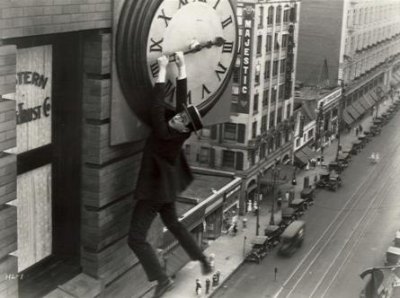
If one image can capture this spirit and enthusiasm if has to be the justly famous picture from Safety Last: Harold hanging from the hands of a clock a dozen stories above the pavement. From the look on his face, you can tell that Harold knows he's in trouble and he's concerned, but not terrified like you or I would be. He's optimistic and knows he'll get out of it, if only he has the time to think of a solution. That single image also illustrates just how far Lloyd would go for a laugh. This isn't someone doing a prat fall, he's risking his all for comedy. (Or so it seems.)
This image, one that people who have never seen a silent film will recognize, is also largely responsible for Lloyd's reputation as a daredevil comic and someone who derived comedy from dangerous situations. Some critics have even unfairly written him off as not much more than a guy hanging off of a building. Though these were some of his most memorable films, the thrill pictures are relatively few in number, and not really representative of his entire body of work. As this set illustrates, Harold Lloyd was a fine comic and filled his movies with many types of gags, but also cared a lot about the plot and characterization.
Like Keaton, Lloyd didn't overact and is able to get a laugh just with a look. For example, in The Freshman when Harold, who is acting as the tackling dummy for the football team, see the line of people who are going to tackle him double in size he just stares. His look is a mixture of resignation and exasperation and it's priceless. He resisted the temptation to go with a broad wide-eyed shocked look and the scene is much more enjoyable due to his underacting.
Lloyd's comedies are different from the other popular silent comics too. They don't have the emotion of Chaplin's or the surrealistic quality of Keaton's but they do have more laughs. Lloyd previewed his movies several times before they were released and tweaked and fine tuned them till the laughs were coming at a good rate. This makes Lloyd's film some of the most laugh filled movies of the silent era.
Another thing that set Lloyd apart from his contemporaries is that he wasn't funny in and of himself. When you see a picture of the glass character, he doesn't seem humorous as Chaplin's tramp, Stan Laurel's blank eyed stare, or the stone-faced Keaton. The key to Lloyd's comedy is that he did funny things. He crafted humorous scenes and gags, put himself in the middle of them, and made it look easy to do. It was his ability to make it all seem natural that made his character so likeable and the comedy so funny.
The Harold Lloyd Comedy Collection:
This set has some incredibly funny movies. Laugh-out-loud funny films. I really enjoyed them all, there's not a dud in the bunch. Not only did I like them, but so did my family. My children (aged 13 and 9) both roared with laughter at all of the films that they saw. These are very accessible to people who haven't seen a lot of silent comedies. They don't come off as hokey or dated, just as good solid entertainment.
My only gripe is that the films are not presented in chronological order. For marketing reasons, they are releasing each two disc set individually also, and they wanted to spread out the features and shorts so that each volume is of equal quality. They did do a great job too. I can't recommend one volume over another, they all have excellent films.
This set contains all of Harold Lloyds feature films with three exceptions (Welcome Danger, Professor Beware, and The Sin of Harold Diddlebock. The last two are not owned by the Harold Lloyd Trust. The first has just been restored, both the silent and sound versions. Hopefully it will be released soon.)
The highlight of volume one is Lloyd's most famous film, Safety Last!. This 1923 feature has Harold in the big city working in a department store as a clerk. When his girl comes to visit him from the country, he is in trouble. He's told her that he's an executive with the firm and she's sure they'll soon have enough money to marry. When Harold overhears his manager pledge $1000 to anyone who can bring more customers into the store, the young go-getter realizes that this is his only chance to make good. He convinces a friend who is a human fly to climb up the outside of the building the store is located in and publicizes the stunt. When the day arrives a crowd has gathered but the friend has a problem, the cops are chasing him and he needs Harold to climb up just a few stories till they can switch places...
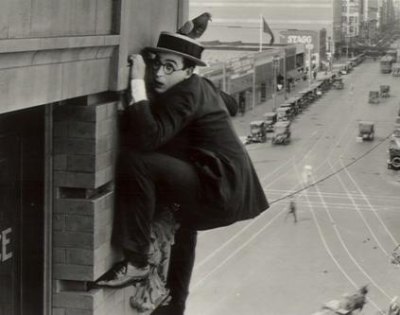
If this was the only film that Harold Lloyd ever made, people would still be talking about it. It's one of those movies were everything comes together perfectly. The gags are all sprinkled evenly through the film and the pace of the movie is just right. The comedy reaches a climax with the climbing scene which is masterfully done. In this scene Lloyd mixes comedy and suspense wonderfully and gives cinema one of the best sequences ever filmed. A very funny film, and one of Lloyd's best.
This volume also has one of Lloyd's best sound features, The Milky Way. This mad-cap comedy was admirably directed by Leo McCarey (Duck Soup, Bells of St. Mary), and has Lloyd in top form.
Lloyd stars as Burleigh Sullivan, an everyman underdog who gets into a situation that rapidly spirals out of control. When Burleigh's sister Mae (Helen Mack) is harassed by a couple of drunk men one evening, he steps in to defend her honor. They pick a fight and in the confusion it appears that Burleigh knocks one of the guys out. Unfortunately the man turns out to be Speed McFarland (William Gargan,) the middle weight boxing champion of the world. This causes no end of embarrassment to the champ, so his manager Gabby (Adolph Menjou) comes up with a plan: They'll make a boxer out of Burleigh and have him fight in some rigged bouts. After he gets a reputation as a tough customer, he'll fight Speed who will clean his clock, thereby regaining his reputation. Of corse, this isn't easy to pull off, especially since Burleigh has no interest in ever getting into the ring.
Though Lloyd is famous for his silent work, this film shows that he can successfully handle fast paced comic dialog as well as slapstick comedy. He is also smart enough to not hog the lime light and the rest of the cast really shines. Menjou is wonderfully comic as Speed's manager, and Helen Mack doesn't get upstaged by her more famous co-stars.
The first volume also has the most atypical of Lloyd's films; the sound feature The Cat's Paw. The weakest film in the set, this was the first time Lloyd had purchased a written work for adaptation. Based on a story by Clarence Budington Kelland a writer for the Saturday Evening Post, Lloyd plays Ezekiel Cobb, a young man who was raised in China and follows the teachings of the Eastern philosopher Ling-Po. Cobb arrives in Stockport California in order to seek a bride. Totally naive and unfamiliar with American customs Cobb is soon convinced to run against the crooked mayor of the town. It's expected that he'll lose and mayor will be in office for another term. When he unexpectedly wins, Cobb realizes how corrupt the town is and sets about cleaning it up.
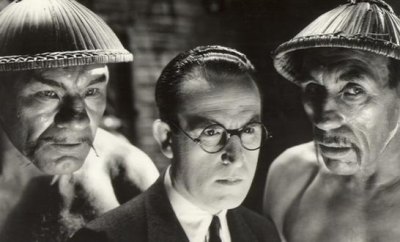 |
| |
Made in the depression, this is a much more political film than Lloyd had made before. The comedy doesn't come from slapstick of gags, it's more of a situational comedy and doesn't have the charm of Lloyd's earlier work. The film is an interesting experiment, and shows that Lloyd was trying to change with the times. While not as funny as his other films, it does have some good moments. The climax scene where Cobb convinces the crooks in the town to change their ways is funny (though the fascist overtones are a little troubling), and his inscrutable Eastern personality also has some humor to it. Technically the film looks very good, and had another comedian made it, this movie would be above average. It's only when you compare it to his earlier works that this film falls short.
Lloyd's most commercially successful film, and arguably his funniest, The Freshman, is featured on the second volume. This is another one of those films where the various pieces of the film all fit together perfectly.
Harold plays Harold 'Speedy' Lamb (Speedy was Harold's nickname in real life), a freshman at college who's fondest desire is to be one of the popular kids on campus. When he first arrives though, the upperclassmen play a series of tricks on him. He never realizes that they are teasing him and soon is known as the class boob. Totally oblivious, Harold goes about with a cheerful upbeat attitude, and thinks he's well liked. When the truth finally reveals itself he's crushed, and his only hope is to play well in the big football game against his school's rivals. That'll be a little hard to do though, since he's only the water boy.
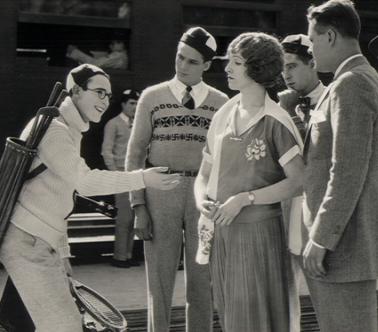
An uproariously funny film, The Freshman has a lot going for it. Viewers instantly feel sorry for the underdog Harold, and the fact that he doesn't realize he's being teased makes him even more pitiful, and the situations more humorous. The "Fall Frolic" when Harold has spent the last of his money on a new suit, only to have it not be completed in time and only loosely stitched is a riot. Viewers laugh and feel nervous at the same time, realizing that more of Harold's clothes will fall of and not sure how he's going to get out of it. The best scene in the film is the last of course, the big football game. Director Preston Sturges had vivid memories of that scene and incorporated it into Lloyd's last film, which he directed, The Sin of Harold Diddlebock. (That is one of the few Lloyd features not available in this set, another company owns the rights.)
This disc also has Harold's second 'thrill picture'; High and Dizzy. Lloyd plays a doctor who has to cure a patient (Mildred Davis) of sleepwalking. Before he goes over to see her though, he drops by a friend's house (Roy Brooks) who has just finished his latest batch of moonshine. They both sample a bit, then a bit more, and by the time Harold arrives at the girl's hotel, he's wildly inebriated. Of course she starts sleep walking, and walks out onto the window ledge, several stories up. Harold goes right after her and manages to get her back inside, where she promptly closes the window on him. Harold sobers up quickly when he realizes how high up he is, but he's still got to get off the side of the building.
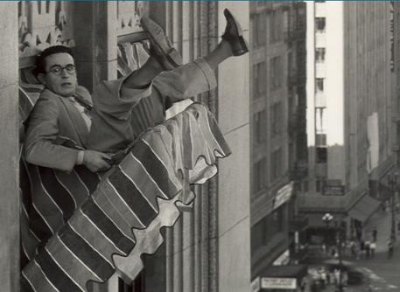
This is a fun and exciting comedy. There were some good gags in the first section but the ending of the film where Harold is hanging off the side of a building was especially entertaining.
This also has the first credited appearance of Roy Brooks in a film. Roy was a good friend of Mildred Davis. After his film career failed to take off he became Harold's personal secretary and lived on Harold's estate for forty years until his death. Openly homosexual, Roy also served as a companion to Mildred while Harold was spending long hours filming.
The final volume in this set has some outstanding films too. It starts off with Speedy, Lloyd's last silent feature and another outstanding film. This movie hasn't been circulated as much as some of his other films, but this one ranks up there with The Freshman and Safety Last! as a comic masterpiece.
Harold plays Speedy, a baseball fan who can't seem to hold a job. His sweetheart, Jane (Ann Christy) helps out her grandfather, Pop, who owns a small trolley route in New York City, the last trolley that's still pulled by horse. A big company is trying to consolidate all the smaller lines and wants to buy up Pop's train and tracks, but they aren't offering much so he won't sell. The only problem is that his agreement with the city states that the trolley has to run at least once every 24 hours or else he loses the lease. When Speedy overhears that some thugs are going to sabotage the trolley so it can't run, he offers to drive it for Pops. If the crooks think it'll be easy stealing the trolley from Speedy, they've got another think coming.
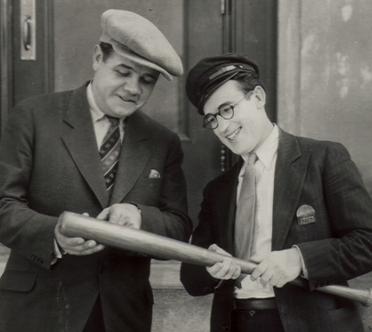
This was Lloyd's final silent picture and he went all out for this one. They filmed on location in New York City, and the movie opens with some lovely shots of the Big Apple the way it looked in 1928. There's also an extended scene that takes place in Coney Island where viewers get to see what that amusement park was like when it was one of the hot spots of the country.
In a lot of ways, this film was like a series of good two reelers strung together with common characters. The film can be divided into several sections that feel a little disconnected from each other but still come together to form a funny film. I actually liked that, since it made the movie feel new and fresh. Every 20 minutes Harold would be in a new setting with new problems and that was a lot of fun. The large fight scene was a hilarious, but I enjoyed the taxi cab sequence the most. That bit ends with Harold picking up Babe Ruth (played by the Bambino himself) in his cab and giving the slugger a harrowing drive to Yankee Stadium. Of course, like all of Lloyd's films, he leaves the funniest and most exciting scenes for last. The race against time at the end is a great climax to Lloyd's silent career.
Another fun film on this volume is the short Never Weaken. It's one of Harold's greatest shorts. The object of Harold's affection, Mildred Davis, is the receptionist at a doctor's office. When Harold hears that she's been fired because of a lack of patients, he sets out to drum up some business for the doctor. He manages to fill the doctor's office, but then overhears Mildred talking to another man and falsely thinks she's in love with another. Not wanting to live without her, he tries to kill himself only to end up out on a girder stories above the ground.
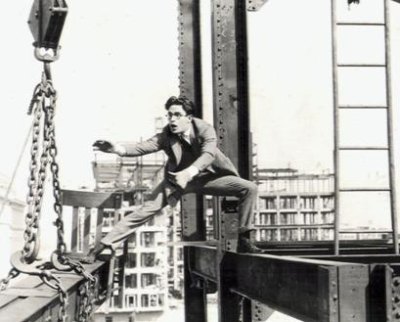
This picture has it all, some great comic gags, spectacular thrills, and a great ending. Harold has his glasses character down pat by this time and really understood what would and wouldn't work in his comedies. One of the best shorts, and a personal favorite.
For Heaven's Sake is another fantastic comedy that my whole family enjoyed. This was the first feature Lloyd made for distribution by Paramount, and he wanted to create a good film to please his new partners. He filled this movie with nonstop gags and stunts that keeps the audience laughing.
J. Harold Manners (Harold Lloyd) is a member of the idle rich. When his chauffeur wrecks his brand-new car, he walks into a dealer and buys another one. When that one also gets totaled in short order, the papers have a field day reporting on the spendthrift.
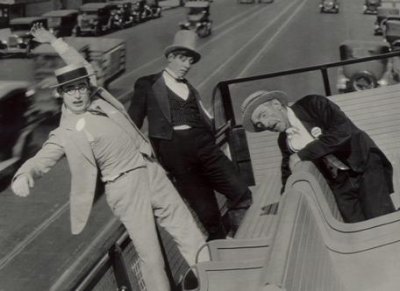
Through a series of accidents and miscommunications, Harold unknowingly supplies the start up funds for a store-front mission to be run by Brother Paul. It is in the city's poorest and toughest neighborhood and Brother Paul naturally names the mission after his benefactor. When Harold gets wind the mission and its name, he assumes they are trying to cash in on his prestige and goes down to the mission in a rage. That is until he sees Brother Paul's daughter, Hope (Jobyna Ralston.) Then it is your proverbial love at first sight. Harold falls hard for the poor working girl, but he needs to impress her somehow. When she mentions that the men in the pool hall down the street never come to the sermons, Harold decides that he'll get the thugs and toughs from the pool hall into the mission one way or another. This leads to a great chase sequence, the first of two, that left people's sides sore from laughter.
This was a very funny film. Lloyd liked to alternate character comedies with gag films, and this is one of the later. This is a gag-a-minute film that has solid laughs all thorough it. Though the chase scenes are the main attractions there are little gags sprinkled throughout the movie, and many of these are just as funny as the more elaborate jokes. The expression on Harold's face when he pops a dirty sponge in his mouth thinking it's a treat that Hope has made is great, and the way he gets it out of his mouth even funnier.
While not as famous as Safety Last! or The Freshman, this film show Lloyd at his creative and comic peak. A wonderfully funny film.
There are many more great films in this set too: Why Worry? is so funny that Universal stole a lot of the gags and scenes for their film The Night Club. Among Those Present, Harold's second three reel comedy is just as good as his features. It has Harold having to impersonate a British aristocrat, with horrible results. Basically, this is all good. Even the weaker films such as Cat's Paw and Feet First are entertaining (and they are much better than Chaplin's and Keaton's worst films.) An absolutely wonderful set.
Volume 1
Disc 1:
Girl Shy (1924)
Safety Last! (1923) w/ commentary by Leonard Maltin and director Richard Correll
An Eastern Westerner (1920)
Ask Father (1919)
From Hand to Mouth (1919)
Disc 2:
The Milky Way (1936)
The Cat's Paw (1934)
Why Worry? (1923)
Featurette Harold's Hollywood: Then and Now
Volume 2
Disc 1:
Kid Brother (1927) w/ commentary by Harold Lloyd's granddaughter Suzanne Lloyd, author Annette D'Agostino Lloyd, and Rich Correll
The Freshman (1925) w /commentary by Leonard Maltin, Richard Correll and author/film historian Richard W. Bann
Bumping Into Broadway (1919)
Billy Blazes, Esq. (1919)
Disc 2:
Feet First (1930)
Grandma's Boy (1922)
Dr. Jack (1922)
Now or Never (1921)
High and Dizzy (1920)
Scoring for Comedy featurette
Volume 3
Disc 1:
Speedy (1928) w/ commentary by Suzanne Lloyd, Annette D'Agostino Lloyd and Richard Correll
Hot Water (1924)
Never Weaken (1921)
Haunted Spooks (1920) w/ commentary by Suzanne Lloyd, Annette D'Agostino Lloyd and Richard Correll
Disc 2:
Movie Crazy (1932)
For Heaven's Sake (1926)
I Do (1921)
Among Those Present (1921)
A Sailor-Made Man (1921)
Get Out and Get Under (1920)
Number Please? (1920)
Greenacres featurette
The DVD:
This set consists of three volumes, each available individually, and a bonus disc that is only available with this boxed set. Each volume consists of two DVDs: a single-sided disc and a double sided one all contained in a single width keepcase. All four discs come in an attractive slipcase.
Audio:
New scores were composed and recorded for the silent features and the talkies have had the sound restored. Everything sounded excellent. The new scores were preformed by orchestras and were scene specific. They had a few sound effects (bells, whistles and such the like) and these were done by the musicians. The stereo recordings were very clear and really worked well with the films.
Video:
All of these films have been restored from original elements held by the Harold Lloyd Trust, and they look absolutely fantastic. This is the way that silent films were meant to be seen, with crystal clear images and fine details. There were a very few minor instances of damage, the beginning of Speedy had some scratches during the first few seconds, most probably on the camera negative itself, but that was the rare exception rather than the rule. Spots of dirt which I expect to see even in restored films were almost totally absent. The image had excellent contrast and wasn't jittery. On top of that, this set wasn't created from PAL masters like the Charlie Chaplin sets so the defects associated with that (blurred frames and a 4% increase in speed) aren't a worry. One of the best looking silent restorations ever.
Extras:
Each of the volumes in this set has it's own set of extras. All of them contain production galleries of stills and commentaries, and each volume also has a featurette. The commentaries were all good. Leonard Maltin does two (for Safety Last! with Richard Correll and The Freshman with Richard Correll and film historian Richard W. Bann) and these were my favorites, though the ones with Suzanne Lloyd (Harold's grandaughter), Annette D'Agostino Lloyd (Lloyd fan and scholar) and director Richard Correll are also fun to listen too. Though some information is repeated between the commentaries, they are all filled with interesting anecdotes and stories about Harold as well as the film and Lloyd's costars. A fine set of commentaries that don't become boring or dull.
The first disc also has Harold Lloyd's Hollywood: Then and Now. This 8½-minute film features Annette D'Agostino Lloyd visiting some of the locations that Lloyd filmed and comparing what they looked like then with how they appear now. It was okay, but not really my area of interest.
Scoring for Comedy appears in the second volume and looks at how the various composers wrote scores for these films. Robert Israel and Carl Davis are interviewed in this 15 minute documentary and they talk about their scores as well as the music that originally accompanied silent films.
My favorite featurette on these discs was on Greenacres, Harold's luxurious estate in Beverly Hills. Suzanne Lloyd, who grew up in the house, gives a tour of the house and grounds. The contemporary footage is intercut with home movies that Harold and his crew took over the years. A very nice featurette about a magnificent home.
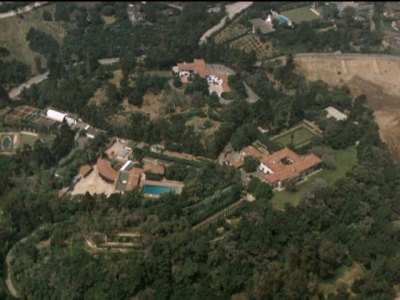
The boxed set also includes an extra bonus disc that isn't available separately. This disc has a wealth of information for both the novice fan and scholar. The material covers not only Harold Lloyd, but also his leading ladies, directors, and others involved in making his films.
This bonus disc is set up a little differently than most other discs. Instead of a couple of features, there are many short clips (most of them being 2-5 minutes) that can be accessed from different places on the disc. The disc has a nice overview hosted by Leonard Maltin, and then the viewer can explore the disc based on what topic they are most interested in. The disc is arranged by chronologically and by movie.
While the format of this disc seemed a little odd at first, it is easy to get used to. There is also an index which is very helpful when you want to find a particular clip. As for the content, I was very pleased with it. There are some great short interviews including ones with Kevin Brownlow, Debbie Reynolds, and John Landis.
There are a couple of featurettes that are a lot of fun to watch too. Keep 'em Rollin': Making Movies in the Silent Era is a 15-minute introduction to silent film production. This is a great short. In a very short time they cover just about all of the material used in making a silent film, how it worked, and what the advantages and disadvantages were. From carbon arc lights to panchromatic stock to Pathe cameras and cinematography, this is a very complete and concise film. An excellent feature.
Another featurette that was longer than average is Remembering Harold. This 12-minute interview with Gloria Lloyd, Harold's daughter, and Suzanne Lloyd, his granddaughter, was touching and interesting. The interview was conducted by Leonard Maltin, and he asks about the glove that Harold wore (he lost the thumb and first finger in an accident early in his career and wore specially made glove that hid the damage in all of his films) and what it was like growing up the child of a movie star.
That's not all though. In addition to the wealth of new interviews, there are short biographies of the people that Harold worked with from Hal Roach to Snub Pollard. There is a very comprehensive filmography listing not only Lloyd's films, but also his TV and radio appearances.
Harold Lloyd liked working with the talented crew that he managed to bring together, so he kept them on salary year round whether he was filming or not. When one of his children was having a birthday party, he'd call up his crew and have them come out and film it. Naturally, these home movies are very professional and polished looking, and there are several available on this disc, including footage of the Lloyd's at Greenacres.
Harold was an avid photographer, and this disc has many stills of he and his family, including a gallery of the 3-D photography that he experimented with. A pair of glasses to view the 3-D images are included. When viewing these on my CRT TV, the effect was okay, but I did have some trouble with the 3-d effects. They looked much better on my computer screen.
Lastly, there is film of several appearances by Harold at various functions. The USC's Delta Kappa Alpha tribute to Harold Lloyd is hosted by Jack Lemmon and Steve Allen and runs nearly half an hour. Harold talks about his coming to California and the early days of motion pictures. The acceptance speech that Harold gave when he won an Academy Award which was presented in 1953 is also here, as well as an introduction he filmed for The Freshman.
If you have a computer equipped with a DVD-Rom drive, there is also Harold Lloyd's Media Vault. This is a searchable index of all of the content on the disc. You can type in Shirley Temple, and find pictures of the young starlet that Harold took. The interface is very nice and it adds a lot to the disc.
Final Thoughts:
Harold Lloyd films were the first feature length silent films that I ever saw. In the late 70's PBS broadcast one of his films every Saturday night, and it was the highpoint of my weekend. It was these films that sparked my interest in the silent era, and I'm very glad that they are still as funny as I remember them being. I laughed and laughed through this entire set.
This collection isn't only for silent film afficionados though, it is great family entertainment. My wife and kids screened several of these films with me, and they enjoyed everything that they saw. Minute for minute, these films have more laughs than any others I can think of off hand.
Not only are these films very good, but they are restored and look absolutely beautiful. These look like they were shot last year rather than 80 years ago. Added to that are the newly composed scores that fit the films perfectly, and the copious bonus material which really makes this an outstanding set. If I could only make one DVD purchase this year, I'd pick up this set. This set of films easily belongs in the DVD Talk Collector Series.
|
| Popular Reviews |
| Sponsored Links |
|
|
| Sponsored Links |
|
|
| Release List | Reviews | Shop | Newsletter | Forum | DVD Giveaways | Blu-Ray | Advertise |
|
Copyright 2024 DVDTalk.com All Rights Reserved. Legal Info, Privacy Policy, Terms of Use,
Manage Preferences,
Your Privacy Choices | |||||||









